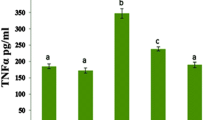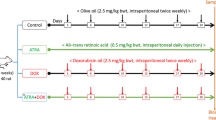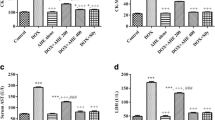Abstract
Ferulic acid (FA) is a phenolic compound with potent antioxidant activity. The objective of the study was to study the protective effects of FA on doxorubicin (Dox)-induced myocardial toxicity in rats. Wistar rats received vehicle (control) or Dox (20 mg/kg, i.p.) or telmisartan (Tel; 10 mg/kg, p.o.) or ferulic acid (20 mg/kg and 40 mg/kg, p.o.) for 7 days followed by treatment with Dox (20) on the fifth day of treatment, except the control group. On day 8, electrocardiographic parameters were recorded followed by blood withdrawal and then the animals were sacrificed for histopathology. Administration of Dox showed prolonged RR, QTc interval, and QRS complex. The levels of serum CK-MB, LDH, IL-1β, and IL-6 were significantly increased (p < 0.01). Similarly, levels of Ca+2, Mg+2 ATPase, and Ca+2 ATPase and expression of ANP and BNP were significantly higher as compared to the control. In the FA-treated group, ECG was normal. The serum levels of CK-MB, LDH, IL-1β, and IL-6 were not elevated. Heart tissue Ca+2, Mg+2 ATPase, and Ca+2 ATPase did not show a statistical difference compared to the control group. The FA treatment attenuated the expression of ANP and BNP. FA (20 and 40) augmented myocardial GSH and Na+/K+ ATPase. Histopathology of the heart confirmed the cardioprotective effect of FA.




Similar content being viewed by others
References
Abdel-Wahab M, El-Mahdy M, Abd-Ellah M, Helal G, Khalifa F, Hamada F (2003) Influence of p-coumaric acid on doxorubicin-induced oxidative stress in rat’s heart. Pharmacol Res 48:461–465
Alimoradi H, Barzegar-Fallah A, Hassanzadeh G, Mohammadi-Rick S, Asadi F, Delfan B (2012) The cardioprotective effects of an antiemetic drug, tropisetron, on cardiomyopathy related to doxorubicin. Cardiovasc Toxicol 12:318–325
Al-Majed A, Gado A, Al-Shabanah O, Mansour M (2002) Alpha-lipoic acid ameliorates myocardial toxicity induced by doxorubicin. Pharmacol Res 46:499–503
Aswar U, Mahajan U, Nerurkar G, Aswar M (2013) Amelioration of cardiac hypertrophy induced by abdominal aortic banding in ferulic acid treated rats. Biomed Aging Pathol 3:209–217
Balachandar A, Malarkodi K, Varalakshmi P (2003) Protective role of D La-lipoic acid against adriamycin-induced cardiac lipid peroxidation. Hum Exp Toxicol 22:249–254
Bujak M, Frangogiannis N (2009) The role of IL-1 in the pathogenesis of heart disease. Arch Immunol Ther Exp 57:165–176
Buyukokuroglu M, Taysi S, Buyukavci M, Bakan E (2004) Prevention of acute adriamycin cardiotoxicity by dantrolene in rats. Hum Exp Toxicol 23:251–256
Chen M, Yang S, Chou C, Yang K, Wu C, Cheng Y (2010) The chondroprotective effects of ferulic acid on hydrogen peroxide-stimulated chondrocytes: inhibition of hydrogen peroxide-induced pro-inflammatory cytokines and metalloproteinase gene expression at the mRNA level. Inflamm Res 59:587–595
Cianchetti S, Del Fiorentino A, Colognato R, Di Stefano R, Franzoni F, Pedrinelli R (2008) Anti-inflammatory and anti-oxidant properties of telmisartan in cultured human umbilical vein endothelial cells. Atherosclerosis 198(1):22–28
de Oliveira Silva E, Batista R (2017) Ferulic acid and naturally occurring compounds bearing a feruloyl moiety: a review on their structures, occurrence, and potential health benefits. Compr Rev Food Sci Food Saf 16(4):580–616
Dodd D, Atkinson J, Olson R, Buck S, Cusack B, Fleischer S (1993) Doxorubicin cardiomyopathy is associated with a decrease in calcium release channel of the sarcoplasmic reticulum in a chronic rabbit model. J Clin Invest 91:1697–1705
Fadillioglu E, Oztas E, Erdogan H, Yagmurca M, Sogut S, Ucar M (2004) Protective effects of caffeic acid phenethyl ester on doxorubicin-induced cardiotoxicity in rats. J Appl Toxicol 24:47–52
Gao S, Long C, Wang R, Wang H (2009) KATP activation prevents progression of cardiac hypertrophy to failure induced by pressure overload via protecting endothelial function. Cardiovasc Res 83:444–456
Hadi N, Yousif G, Al-Amran HN, Mohammad B, Ali S (2012) Vitamin E and telmisartan attenuates doxorubicin induced cardiac injury in rat through down regulation of inflammatory response. BMC Cardiovasc Disord 12(1):63–70
Henninger C, Huelsenbeck J, Huelsenbeck S, Grosch S, Schad A, Lackner K (2012) The lipid lowering drug lovastatin protects against doxorubicin-induced hepatotoxicity. Toxicol Appl Pharmacol 261:66–73
Hjerten S, Pan H (1983) Purification and characterization of two forms of a low-affinity Ca2+-ATPase from erythrocyte membranes. Biochim Biophys Acta Biomembr 728:281–288
Hortobagyi G (1997) Anthracyclines in the treatment of cancer. Drugs 54(4):1–7
Hou Z, Yang J, Zhao R, Yuan J (2004) Ferulic acid inhibits vascular smooth muscle cell proliferation induced by angiotensin II. Eur J Pharmacol 499:85–90
Iqbal M, Dubey K, Anwer T, Ashish A, Pillai K (2008) Protective effects of telmisartan against acute doxorubicin-induced cardiotoxicity in rats. Pharmacol Rep 60(3):382–390
Kalivendi S, Konorev E, Cunningham S, Vanamala S, Kaji E, Joseph J (2005) Doxorubicin activates nuclear factor of activated T-lymphocytes and Fas ligand transcription: role of mitochondrial reactive oxygen species and calcium. Biochem J 389:527–539
Kania G, Blyszczuk P, Eriksson U (2009) Mechanisms of cardiac fibrosis in inflammatory heart disease. Trends Cardiovasc Med 19:247–252
Kim DH, Landry IIIAB, Lee YS, Katz AM (1989) Doxorubicin-induced calcium release from cardiac sarcoplasmic reticulum vesicles. J Mol Cell Cardiol 21(5):433–436
Kobayashi N, Ohno T, Yoshida K, Fukushima H, Mamada Y, Nomura M, Hirata H, Machida Y, Shinoda M, Suzuki N, Matsuoka H (2008) Cardioprotective mechanism of telmisartan via PPAR-γ-eNOS pathway in dahl salt-sensitive hypertensive rats. Am J Hypertens 21(5):576–581
Kojima R, Toyama Y, Ohnishi S (1994) Protective effects of an aged garlic extract on doxorubicin-induced cardiotoxicity in the mouse. Nutr Cancer 22(2):163–173
Ludke A, Sharma A, Singal P (2010) Vitamin C modulates doxorubicin-induced cardiotoxicity by reducing oxidative stress and p53 activation. Can J Cardiol 26:71–72d
Ludke L, Al-Shudiefat A, Dhingra S, Jassal D, Singal P (2009) A concise description of cardioprotective strategies in doxorubicin-induced cardiotoxicity. Can J Physiol Pharm 87(10):756–763
Mancuso C, Santangelo R (2014) Ferulic acid: pharmacological and toxicological aspects. Food Chem Toxicol 65:185–195
Maurya D, Devasagayam TPA (2010) Antioxidant and prooxidant nature of hydroxycinnamic acid derivatives ferulic and caffeic acids. Food Chem Toxicol 48(12):3369–3373
Mohamad R, El-Bastawesy A, Zekry Z, Al-Mehdar H, Al-said M, Aly S (2009) The role of Curcuma longa against doxorubicin (adriamycin)-induced toxicity in rats. J Med Food 12:394–402
Moron M, Depierre J, Mannervik B (1979) Levels of glutathione, glutathione reductase and glutathione S-transferase activities in rat lung and liver. Biochim Biophys Acta Gen Subj 582:67–78
Nagi M, Almakki H (2009) Thymoquinone supplementation induces quinone reductase and glutathione transferase in mice liver: possible role in protection against chemical carcinogenesis and toxicity. Phytother Res 23:1295–1298
Nousiainen T, Jantunen E, Vanninen E, Remes J, Vuolteenaho O, Hartikainen J (1999) Natriuretic peptides as markers of cardiotoxicity during doxorubicin treatment for non-Hodgkin’s lymphoma. Eur J Haematol 62:135–141
Octavia Y, Tocchetti C, Gabrielson K, Janssens S, Crijns H, Moens A (2012) Doxorubicin-induced cardiomyopathy: from molecular mechanisms to therapeutic strategies. J Mol Cell Cardiol 52:1213–1225
Ohnishi T, Suzuki T, Suzuki Y, Ozawa K (1982) A comparative study of plasma membrane Mg2+-ATPase activities in normal, regenerating and malignant cells. Biochim Biophys Acta Biomembr 684:67–74
Oktem G, Uysal A, Oral O, Sezer E, Olukman M, Erol A (2012) Resveratrol attenuates doxorubicin-induced cellular damage by modulating nitric oxide and apoptosis. Exp Toxicol Pathol 64:471–479
Piazzon A, Vrhovsek U, Masuero D, Mattivi F, Mandoj F, Nardini M (2012) Antioxidant activity of phenolic acids and their metabolites: synthesis and antioxidant properties of the sulfate derivatives of ferulic and caffeic acids and of the acyl glucuronide of ferulic acid. J Agric Food Chem 60:12312–12323
Potemski P, Polakowski P, Wiktorowska-Owczarek A, Owczarek J, Pluzanska A, Orszulak-Michalak D (2006) Amifostine improves hemodynamic parameters in doxorubicin-pretreated rabbits. Pharmacol Rep 58:966–972
Pugazhendhi A, Edison T, Velmurugan B, Jacob J, Karuppusamy I (2018) Toxicity of doxorubicin (dox) to different experimental organ systems. Life Sci 200:26–30
Radwan R, Shaban E, Kenawy S, Salem H (2012) Protection by low-dose γ radiation on doxorubicin-induced nephropathy in rats pretreated with curcumin, green tea, garlic or l-carnitine. Bull Fac Pharm Cairo Univ 50:133–140
Rossi F, Filippelli W, Russo S, Filippelli A, Berrino L (1994) Cardiotoxicity of doxorubicin: effects of drugs inhibiting the release of vasoactive substances. Pharmacol Toxicol 75:99–107
Sampath P, Vijayaragavan K (2008) Ameliorative prospective of alpha-mangostin, a xanthone derivative from Garcinia mangostana against β-adrenergic cathecolamine-induced myocardial toxicity and anomalous cardiac TNF-α and COX-2 expressions in rats. Exp Toxicol Pathol 60:357–364
Shadle S, Bammel B, Cusack B, Knighton R, Olson S, Mushlin P (2000) Daunorubicin cardiotoxicity: evidence for the importance of the quinone moiety in a free-radical-independent mechanism. Biochem Pharmacol 60:1435–1444
Singal PK, Iliskovic N (1998) Doxorubicin-induced cardiomyopathy. N Engl J Med 339:900–905
Singal P, Panagia V (1984) Direct effects of adriamycin on the rat heart sarcolemma. Res Commun Chem Pathol Pharmacol 43:67–77
Srinivasan M, Sudheer A, Menon V (2007) Ferulic acid: therapeutic potential through its antioxidant property. J Clin Biochem Nutr 40:92–110
Tacar O, Sriamornsak P, Dass CR (2013) Doxorubicin: an update on anticancer molecular action, toxicity and novel drug delivery systems. J Pharm Pharmacol 65(2):157–170
Trombino S, Cassano R, Bloise E, Muzzalupo R, Tavano L, Picci N (2009) Synthesis and antioxidant activity evaluation of a novel cellulose hydrogel containing trans-ferulic acid. Carbohydr Polym 75:184–188
Vallejo J, Salazar L, Marcelo G (2017) Oxidative stress modulation and ROS-mediated toxicity in cancer: a review on in vitro models for plant-derived compounds. Oxid Med Cell Longev 1–9
Yu J, Wang C, Kong Q, Wu X, Lu J, Chen X (2018) Recent progress in doxorubicin-induced cardiotoxicity and protective potential of natural products. Phytomed 40:125–139
Zhang S, Liu X, Bawa-Khalfe T, Lu L, Lyu Y, Liu L (2012) Identification of the molecular basis of doxorubicin-induced cardiotoxicity. Nat Med 18:1639–1642
Acknowledgements
The authors would like to acknowledge Prof. M. N. Navale, Founder, STES, and Dr. K. G. Bothara, Principal, SIOP, for providing the necessary facilities to carry out the research work.
Author information
Authors and Affiliations
Corresponding author
Ethics declarations
The experimental protocol was approved by the Institutional Animal Ethical Committee (IAEC) of SIOP, Pune, constituted as per the Committee for Purpose of Supervision and Control on the experimental animal CPCSEA reg. no 1139/a/07/ CPCSEA (Protocol approval no. SIOP/IAEC/2012/21B).
Conflict of interest
The authors declare that there are no conflicts of interest.
Additional information
Publisher’s note
Springer Nature remains neutral with regard to jurisdictional claims in published maps and institutional affiliations.
Rights and permissions
About this article
Cite this article
Aswar, U., Mahajan, U., Kandhare, A. et al. Ferulic acid ameliorates doxorubicin-induced cardiac toxicity in rats. Naunyn-Schmiedeberg's Arch Pharmacol 392, 659–668 (2019). https://doi.org/10.1007/s00210-019-01623-4
Received:
Accepted:
Published:
Issue Date:
DOI: https://doi.org/10.1007/s00210-019-01623-4




